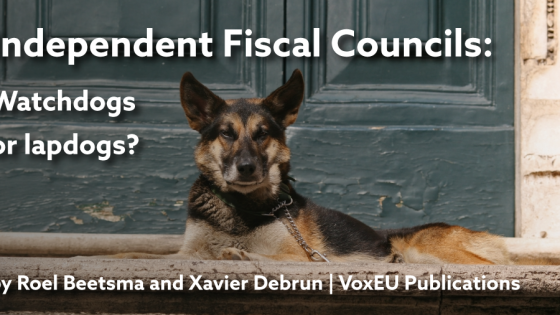In the last ten years, independent fiscal institutions (IFIs) have become an integral part of national fiscal governance frameworks. Globally, governments of around 50 mostly advanced economies rely on technical bodies, run by non-elected experts, mandated to offer a non-partisan assessment of fiscal policy. In the EU, all member states have established at least one or have publicly announced the establishment of an IFI.
To be clear, throughout the ages and in all parts of the world rulers and governments have relied on advisors including on questions of how to best raise taxes and debt. What distinguishes today’s IFIs is their independence, their capacity and willingness to provide objective assessments publicly and free from political influence or the influence of specific interest groups. The raison d’etre of IFIs is linked to the complexity and political nature of fiscal policy making. IFIs are meant to reduce the information asymmetry between politicians and voters with the ultimate aim to align policy decisions with voters’ preferences.
Whether and to what extent IFIs actually meet their objective very much depends on how independent they are. Unfortunately, there is no commonly shared definition (yet) of what makes a fiscal council truly independent. Theoretical and empirical studies do highlight a number of attributes fiscal councils should have to be considered independent. However, the actual landscape of EU IFIs also shows that such attributes are neither necessary nor sufficient conditions. Some IFIs may not look very independent on paper but are very much so in practice and vice versa.
An assessment of safeguards anchored in EU law
This contribution attempts to gauge the degree of independence of all EU IFIs highlighting issues and trade-offs. We circumvent the objective difficulty to conclusively define or measure independence with a two-pronged strategy. Firstly, in the literature there are alternative catalogues of independence safeguards.
They partly overlap but also exhibit differences. Choosing one over the other would be arbitrary. We therefore strictly focus on safeguards defined in EU law.
Secondly, we present alternative rankings of independence by attaching different weights to two broad types of safeguards, (i) those representing formal or legal dimensions of independence, and (ii) those linked to more operational or practical aspects.
According to the latest reform of the EU fiscal framework, IFIs will need to meet the following broad features:
- Structural independence endowed with functional autonomy from the national budgetary authority established by national law, regulations or binding administrative provisions.
- Nomination and appointment of members based on experience and competence through transparent procedures.
- Take no instructions from the budgetary authority of the member state or other entities.
- Capacity to communicate publicly about their assessments and opinions in a timely manner. Member states need to comply with those assessments or shall explain publicly and within two months why they are not following them.
- Adequate and stable resources to carry out their tasks in an effective manner.
- Adequate and timely access to information.
- Regular external evaluations by independent entities.
We consider the first three items as features pertaining to the formal or legal structure of an IFI; the remaining four are more reflective of how they operate in practice. This classification or distinction is to some extent subjective, and some readers may object. We nevertheless use it, not because we believe it is waterproof but to show how assessments of independence may be influenced by different appreciations of the relative importance of different types of safeguards.
Our main sources of information are the existing IFI databases of international organisations, i.e. the European Commission, the IMF, and the OECD as well as a dedicated survey conducted by the European Fiscal Board (EFB) Secretariat at the turn of 2023-2024.
In terms of institutional coverage, we calculate our independence index for 31 IFIs from 26 member states, i.e. all entities that carry out tasks mandated by relevant EU laws, and are therefore concerned by the above safeguards.
The results are presented across three distinct scenarios: neutral, legal, and practice. The neutral scenario serves as an agnostic reference point by attributing equal weights to all the seven EU safeguards.
The legal scenario focuses on the formal framework by attaching a higher weight to the first three legal dimensions. The practice scenario, in contrast, assigns higher weights to the four more operational dimensions. The results of these three scenarios are shown in Figure 1. Due to the categorical nature of the underlying data, the rankings are purely ordinal, i.e. they only show values as higher or lower in scale. They do not say anything about the degree of variation between the relative positions.
Figure 1 European Fiscal Board (EFB) independent fiscal institutions (IFI) independence index rankings
Source: Own calculations based on the data sources detailed in Jankovics and Larch (2024)
Moving from neutral to either legal or practice-focused weightings yields interesting insights. In the legal scenario, Slovakia, Slovenia (FC), and Belgium (FPB) are at the top of the ranking. They were typically established with a constitutional law and the nomination process encompasses detailed specifications for professional experience and/or educational attainment. In the practice scenario, IFIs at the top of the ranking typically benefit from stable financing arrangements, publish analytical outputs beyond compulsory reports, and underwent an external evaluation at least once already.
More generally, our exercise shows how more seasoned fiscal councils, those established well before EU law made them mandatory – such as traditional forecasting bodies plus the Danish and Swedish fiscal councils – often rank much better when the focus is on practical dimensions. The Dutch CPB, for instance, jumps 26 positions when moving from the legal to the practice-based weights. The operations and autonomy of these institutions had been safeguarded for decades by conventions rather than rules, and although some aspects have been formalised following the 2011-2013 economic governance reforms, they still benefit from a relatively stronger de facto than de jure independence.
There is, in fact, a growing literature showing that cultural traits and the stage of historical development influence specific institutional outcomes. Inspired by Tabellini (2008), and to illustrate the possible impact of such underlying drivers for IFIs, Figure 2 plots the legal scenario of our independence index against two variables of interest: (i) the overall quality of government institutions proxied by an indicator taken from the World Bank database of governance indicators (WGI),
and (ii) the level of trust as measured by the latest vintage of the European Values Study.
Figure 2 EFB legal index of EU independent fiscal institutions (IFIs) versus the quality of national governance and trust
Source: World Bank’s Worldwide Governance Indicators, own calculations, European Values Study.
Note: For the five EU Member States with two IFIs, the average of the institution-specific index was computed.
While the fit is far from perfect, the two graphs point to a negative correlation between the strength of the legal safeguards and the two proxies of what one could call the level of societal and institutional development. In plain words: countries characterised by a higher degree of general trust among citizens or well-functioning institutions feel less of a need to explicitly codify the operations of their IFIs. In turn, countries with less social trust and weaker institutional outcomes are keen to lay down written safeguards. Overall, this finding supports the more general results of Tabellini (2008) for the specific case of IFIs.
Conclusions
This column introduces a new index of independence of EU fiscal councils built on the safeguards laid down in EU law. The safeguards are set to become binding for all 27 EU IFIs by the end of 2025, the formal deadline to transpose the relevant EU directive. Cognisant of the fact that de jure independence does not necessarily translate into de facto independence, we have simulated alternative weighting schemes to better understand how EU IFIs fare in terms of the different types of safeguards.
Our indices show that EU IFIs are to a large extent aligned with the more formalistic safeguards. To a certain extent, this is the direct result of their very general nature: they can accommodate very heterogeneous national practice. In turn, there are important differences across IFIs when it comes to the practical aspects of independence. When juxtaposing our IFI index with variables representing underlying cultural norms and institutional development, we find that countries with less social trust and weaker institutional frameworks are more prone to codify in detail the governing provisions for their fiscal councils. This is not to suggest adherence to legally defined minimum requirements is futile. Although they cannot substitute for a history of supportive cultural norms, in the early life of a new IFI they certainly help as reference when in doubt.
Going forward, while one cannot expect from EU law to explicitly codify all desirable features of a national IFI advocated by academics and international organisations, there is certainly further scope for moving towards more granularity in support of the advancement of the EU IFIs.
Authors’ note: The views expressed in this column are those of the authors and do not necessarily reflect those of the European Fiscal Board or the European Commission.
References
Jankovics, L and M Larch (2024), “Independence safeguards: how do national EU IFIs fare?’”, Paper presented at the European Fiscal Board’s 6th annual conference, 17 May, Brussels.
Maskin, E (2016), “Should Fiscal Policy be Set by Politicians?”, Jean Monnet Lecture at the First ECB Annual Research Conference, September.
Network of EU IFIs (2016), “Defining and enforcing minimum standards for independent fiscal institutions”, Network of EU Independent Fiscal Institutions, Brussels.
OECD (2014), “Recommendation of the Council on Principles for Independent Fiscal Institutions”, OECD Senior Budget Officials (SBO), OECD Network of Parliamentary Budget Officials and independent fiscal institutions (PBO).
Tabellini, G (2008), “Culture and institutions (Presidential address)”, Journal of the European Economic Association 6(2-3): 255-294.
Von Trapp, L and S Nicol (2018), “Measuring IFI independence: A first pass using the OECD IFI database”, in R Beetsma and X Debrun (eds), Independent Fiscal Councils: Watchdogs or Lapdogs?, CEPR Press.
Annex
Alternative rankings of IFI independence
Source: own calculations.
Notes: Ranking according to index variations. Differences are computed relative to values in the EFB neutral scenario. Chiefly linked to the fact that there are non-OECD EU Member States, the OECD index covers only 19 entities from the 31 EU IFIs under review in this article.









